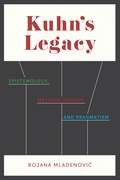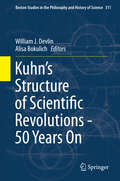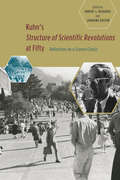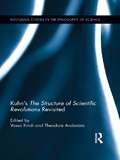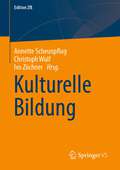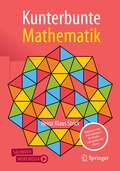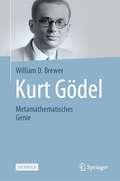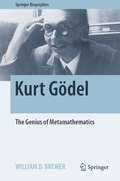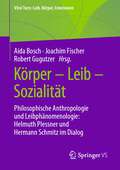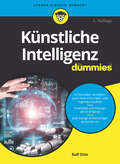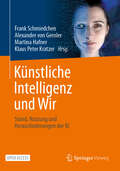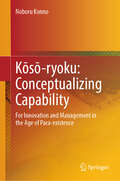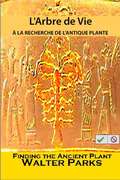- Table View
- List View
Kuhn's Legacy: Epistemology, Metaphilosophy, and Pragmatism
by Bojana MladenovićThomas Kuhn’s The Structure of Scientific Revolutions is one of the most important books of the twentieth century. Its influence reaches far beyond the philosophy of science, and its key terms, such as “paradigm shift,” “normal science,” and “incommensurability,” are now used in both academic and public discourse without any reference to Kuhn. However, Kuhn’s philosophy is still often misunderstood and underappreciated. In Kuhn’s Legacy, Bojana Mladenović offers a novel analysis of Kuhn’s central philosophical project, focusing on his writings after Structure.Mladenović argues that Kuhn’s historicism was always coupled with a firm and consistent antirelativism but that it was only in his mature writings that Kuhn began to systematically develop an original account of scientific rationality. She reconstructs this account, arguing that Kuhn sees the rationality of science as a form of collective rationality. At the purely formal level, Kuhn’s conception of scientific rationality prohibits obviously irrational beliefs and choices and requires reason-responsiveness as well as the uninterrupted pursuit of inquiry. At the substantive, historicized level, it rests on a distinctly pragmatist mode of justification compatible with a notion of contingent but robust scientific progress. Mladenović argues that Kuhn’s epistemology and his metaphilosophy both represent a creative and fruitful continuation of the tradition of American pragmatism. Kuhn’s Legacy demonstrates the vitality of Kuhn’s philosophical project and its importance for the study of the philosophy and history of science today.
Kuhn's Structure of Scientific Revolutions - 50 Years On
by Alisa Bokulich William J. DevlinIn 1962, the publication of Thomas Kuhn's Structure 'revolutionized' the way one conducts philosophical and historical studies of science. Through the introduction of both memorable and controversial notions, such as paradigms, scientific revolutions, and incommensurability, Kuhn argued against the traditionally accepted notion of scientific change as a progression towards the truth about nature, and instead substituted the idea that science is a puzzle solving activity, operating under paradigms, which become discarded after it fails to respond accordingly to anomalous challenges and a rival paradigm. Kuhn's Structure has sold over 1. 4 million copies and the Times Literary Supplement named it one of the "Hundred Most Influential Books since the Second World War. " Now, fifty years after this groundbreaking work was published, this volume offers a timely reappraisal of the legacy of Kuhn's book and an investigation into what Structure offers philosophical, historical, and sociological studies of science in the future.
Kuhn's Structure of Scientific Revolutions at Fifty
by Robert J. Richards Lorraine DastonThomas S. Kuhn's The Structure of Scientific Revolutions was a watershed event when it was published in 1962, upending the previous understanding of science as a slow, logical accumulation of facts and introducing, with the concept of the "paradigm shift," social and psychological considerations into the heart of the scientific process. More than fifty years after its publication, Kuhn's work continues to influence thinkers in a wide range of fields, including scientists, historians, and sociologists. It is clear that The Structure of Scientific Revolutions itself marks no less of a paradigm shift than those it describes. In Kuhn's "Structure of Scientific Revolutions" at Fifty, leading social scientists and philosophers explore the origins of Kuhn's masterwork and its legacy fifty years on. These essays exhume important historical context for Kuhn's work, critically analyzing its foundations in twentieth-century science, politics, and Kuhn's own intellectual biography: his experiences as a physics graduate student, his close relationship with psychologists before and after the publication of Structure, and the Cold War framework of terms such as "world view" and "paradigm."
Kuhn's Structure of Scientific Revolutions at Fifty: Reflections on a Science Classic
by Lorraine Daston Robert J. Richards and Lorraine DastonThomas S. Kuhn’s The Structure of Scientific Revolutions was a watershed event when it was published in 1962, upending the previous understanding of science as a slow, logical accumulation of facts and introducing, with the concept of the “paradigm shift,” social and psychological considerations into the heart of the scientific process. More than fifty years after its publication, Kuhn’s work continues to influence thinkers in a wide range of fields, including scientists, historians, and sociologists. It is clear that The Structure of Scientific Revolutions itself marks no less of a paradigm shift than those it describes. In Kuhn’s “Structure of Scientific Revolutions” at Fifty, leading social scientists and philosophers explore the origins of Kuhn’s masterwork and its legacy fifty years on. These essays exhume important historical context for Kuhn’s work, critically analyzing its foundations in twentieth-century science, politics, and Kuhn’s own intellectual biography: his experiences as a physics graduate student, his close relationship with psychologists before and after the publication of Structure, and the Cold War framework of terms such as “world view” and “paradigm.”
Kuhn's The Structure of Scientific Revolutions Revisited (Routledge Studies in the Philosophy of Science)
by Theodore Arabatzis Vasso KindiThe year 2012 marks the 50th anniversary of the publication of Thomas S. Kuhn’s The Structure of Scientific Revolutions. Up until recently, the book’s philosophical reception has been shaped, for the most part, by the debates and the climate in philosophy of science in the 1960s and 1970s; this new collection of essays takes a renewed look at this work. This volume concentrates on particular issues addressed or raised in light of recent scholarship and without the pressure of the immediate concerns scholars had at the time of the Structure’s publication. There has been extensive research on all of the major issues concerning the development of science which are discussed in Structure, work in which the scholars contributing to this volume have all been actively involved. In recent years they have pursued novel research on a number of topics relevant to Structure’s concerns, such as the nature and function of concepts, the complexity of logical positivism and its legacy, the relation of history to philosophy of science, the character of scientific progress and rationality, and scientific realism, all of which are brought together and given new light in this text. In this way, our book makes new connections and undertakes new approaches in an effort to understand the Structure’s significance in the canon of philosophy of science.
Kultur als Unmittelbarkeit des Lebens (Das Bild vom Menschen und die Ordnung der Gesellschaft)
by Rolf KühnBestimmt man radikal phänomenologisch die Kultur als Subjekt wie Objekt ihrer selbst, dann beinhaltet dies eine jeweils gegebene Unmittelbarkeit des Lebens als Originarität aller subjektiv kulturellen Vollzüge. Dies wird methodisch in Auseinandersetzung mit empirischen wie transzendentalen Kulturanalysen wie bei Freud, Husserl, Henry und Derrida aufgegriffen, um sich danach inhaltlichen Manifestationen der Kultur wie Religion, Wissenschaft und Ästhetik zuzuwenden. Leitend bleibt dabei für die Zukunftsbestimmung unserer Kultur eine notwendige ko-pathische Aufmerksamkeit für das Leben, welche die Singularität aller kulturellen Vollzüge über die diskursive Begrenztheit eines rein objektivierenden Verständnisses hinaus am Werk sieht. Dabei wird auch dem Imaginären wie Fiktionalen ihr unumgehbares Recht eingeräumt, wie es besonders in der Kunst als Meta-Genealogie des Individuums und der Gemeinschaftlichkeit zum Ausdruck kommt.
Kulturelle Bildung (Edition ZfE #12)
by Christoph Wulf Ivo Züchner Annette ScheunpflugDas Buch vereinigt die Ergebnisse aktueller theoretischer und empirischer Forschung zur kulturellen Bildung. Untersucht werden zentrale Sparten wie bildende Kunst, Tanz, Musik, Museum und weite Formen kulturellen Engagements sowie unterschiedliche Zielgruppen, wie Schülerinnen und Schüler, Erwachsene, Lehrkräfte und Professionelle aus kunstbezogenen Berufen.
Kulturkritik und Kulturindustrie: Über Traditionelle Kritische Theorie heute
by Ivo RitzerEine heute mit Horkheimer ‚traditionell‘ zu nennende Kritische Theorie hatte einst betont, dass nur Theorie allein richtige Praxis in einer falschen Welt sein könne. Sie insistierte radikal auf der Autonomie des Denkens gegen jeden unvermittelten Aktivismus. Denn nur das Denken könne sich ein Moment nicht-instrumenteller Vernunft bewahren, welches es inmitten des negativen Ganzen zu verteidigen gelte. Bezeichnenderweise scheinen sich von eben diesem Impetus gerade die neu proliferierenden sogenannten ‚Critical Theories‘ der ‚Identitätspolitik‘ durch Depravation kritischen Denkens zu kulturrelativistischem Artenschutz besonders weit entfernt zu haben. Kritische Theorie aber betrieb nicht das Geschäft regressiver Aufklärungsdenunziation, sondern setzte stattdessen vielmehr auf das subversive Potential „ästhetischer Rationalität“ (Adorno). Als deren affirmativer Gegner wirkt heute eine ‚diversifizierte‘ Kulturindustrie, in der völkische Ideologie eine gegenaufklärerische Renaissance erlebt und dem postmodernen Kapitalverhältnis der ideale Rahmen seiner globalen Reproduktion geboten wird. Diese neue alte Kulturindustrie demonstriert: Kultur muss sich wandeln, damit alles so bleibt, wie es ist. Der Band eröffnet eine neue hermeneutische Perspektive auf die Arbeiten von Horkheimer, Adorno, Marcuse et al. Dabei geht es mit dem Fokus theoriebasierter Kulturkritik weder um eine historische Rekonstruktion noch um eine Detailstudie zu ausgewählten Aspekten, sondern um die Frage der Rolle von Kritischer Theorie heute insgesamt. Mithin ergibt sich für den Band neben der Darstellung zentraler Schriften von Horkheimer, Adorno und Marcuse auch der Anspruch eines eigenständigen Beitrags zur kulturkritischen Theoriebildung.
Kunterbunte Mathematik: Begeisternde Erkundungen für Kinder, Lehrende und Eltern
by Heinz Klaus StrickDieses Buch zeichnet ein – im wahrsten Sinne des Wortes – farbenfrohes Bild von Mathematik: Es stellt eine Auswahl von mathematischen Themen vor, die mithilfe durchgehend farbig gestalteter Abbildungen und unterstützt durch möglichst einfache Erläuterungen erschlossen werden. Auf Formeln und Rechnungen wurde soweit wie möglich verzichtet.Das Buch eignet sich insbesondere für Kinder ab etwa 8 Jahren und Jugendliche. Lehrenden und Eltern bietet es entsprechende Anregungen für gemeinsame mathematische Erkundungen. Die einzelnen Kapitel sind im Wesentlichen unabhängig voneinander lesbar, sodass sie möglichst vielseitig einsetzbar sind. Durch regelmäßig eingestreute Anregungen zum Nachdenken und Anstöße für eigene Untersuchungen wird mathematisches Entdecken erlebbar. Lösungshinweise zu diesen Anregungen sowie Kopiervorlagen werden online zur Verfügung gestellt.Die Mehrzahl der Themen wird Leserinnen und Lesern der beliebten Bücher Mathematik ist schön, Mathematik ist wunderschön und Mathematik ist wunderwunderschön bekannt vorkommen – es handelt sich um eine Auswahl von Inhalten aus diesen Büchern, die hier größtenteils völlig neu aufbereitet wurden: Die Darstellungen sind im vorliegenden „kunterbunten“ Buch nochmal sehr viel anschaulicher, ausführlicher und kindgerechter. Außerdem sind weitere Themen hinzugekommen, die sich besonders für jüngere Mathematikinteressierte eignen.
Kurdish Paradox of Statelessness: Öcalan's Confederalism and Turkeyification Strategies (Middle East Today)
by Kamal Soleimani Behrooz ShojaiThis book critically examines Abdullah Öcalan’s proposal of "democratic confederalism," introduced in 2005, and its theoretical and practical implications. Despite its claims to transcend the nation-state model, Öcalan’s project leaves the colonial structures of the Turkish, Persian, and Arab states unchallenged, legitimizing their assimilatory and genocidal tendencies. It fails to secure Kurdish self-determination or protect linguistic and cultural rights, including mother-tongue education. The study interrogates these contradictions, offering a comprehensive critique of Öcalan’s ideology and its limited impact on governance, Kurdish identity, and aspirations for autonomy. Drawing on Öcalan’s original Turkish writings, the book challenges prevailing scholarship that often relies on selective translations and sympathetic interpretations. It reveals the foundational limitations of Öcalan’s approach, exposing the structural barriers it sustains and its complicity in perpetuating Turkification tendencies under the guise of Kurdish politics.
Kurikara: The Sword and the Serpent
by John Maki EvansInMikkyo-Japanese esoteric Buddhism-the dragon Kurikara symbolizes the internal energy developed through sword practice. Kurikara is a manifestation of the fierce bodhisattva Fudo Myo O, the patron of ascetics and warriors in Japan, who uses his sword to destroy delusions and sever attachments. Fudo’s sword represents the gaining of discriminative power and decisiveness-the ability to cut through illusion and attachment. This leads to the development of an inner energy that allows one to “burn up” all obstacles to spiritual freedom. Kurikara: The Sword and the Serpentsets out the eight basic principles of swordsmanship common to all Japanese sword schools, emphasizing the cultivation of power and mental focus. Accomplished martial artist John Evans provides practical examples from his experience with the sword arts as well asMikkyoandshugendo(mountain asceticism). The first foreign student to train with Nakamura Taisaburo sensei-widely acknowledged as the master of the sword artbattodo-Evans clearly explains how skill such as Nakamurua sensei’s can be systematically developed throughtanren, exercises that meld “inner” and “outer” power. Filled with fascinating anecdotes from Evans’s training in Japan,Kurikarais a useful, inspiring guide to Japanese sword practice and its spiritual underpinnings.
Kurt Gödel: Metamathematisches Genie
by William D. BrewerZu seinen Lebzeiten war Kurt Gödel außerhalb der Fachwelt der Mathematiker, Philosophen und theoretischen Physiker kaum bekannt. Zu Beginn seiner Karriere schuf er beeindruckende Arbeiten zur Vollständigkeit und Beweisbarkeit formaler logischer Systeme, die zu seiner Dissertation und seiner Habilitations-schrift wurden und ihn unter Fachleuten weltberühmt machten. Seine Unvoll-ständigkeitssätze läuteten das Ende der formal-logischen Programme der Logizisten (Russell et al.) und der Formalisten (Hilbert et al.) ein. Später erzielte er auch signifikante Ergebnisse in der Mengenlehre. Nach seiner Emigration in die USA (Princeton), widmete er sich mehr der Philosophie, dem Leitmotiv seines Lebens, und er fand auch eine einzigartige Lösung zu Einsteins Feld-gleichungen der Gravitation, sein “Gödel-Universum“. Dieses Buch beschreibt sowohl den Gödel, der ein genialer Wissenschaftler war, und der gewagte und neuartige Hypothesen zu den Fundamenten der Mathe-matik und Physik hervorbrachte, ‒ als auch den Gödel, der ein perfekter Rationalist war, aber sein Alltagsleben nur mit Mühe meistern konnte und zeitlebens unter Depressionen, Angstneurosen und Hypochondrie litt. Ein Leben voller Paradoxen, in dem er trotz all seiner psychischen Probleme Beachtliches leistete und zu einem Vorbild für viele jüngere Wissenschaftler wurde. Das Buch liefert den Kontext zu seinen Errungenschaften, die ein verblüffend breites Spektrum intellektueller Unternehmungen darstellen, und zu seiner zunehmenden Geisteskrankheit; und es zeigt, wie er eine lange und erfolgreiche Karriere mit Hilfe seiner loyalen Ehefrau Adele und einigen seiner Freunde durchlaufen konnte. Dies ist eine faszinierende Geschichte der wissen-schaftlichen Genialität und der menschlichen Natur.
Kurt Gödel: The Genius of Metamathematics (Springer Biographies)
by William D. BrewerDuring his lifetime, Kurt Gödel was not well known outside the professional world of mathematicians, philosophers and theoretical physicists. Early in his career, for his doctoral thesis and then for his Habilitation (Dr.Sci.), he wrote earthshaking articles on the completeness and provability of mathematical-logical systems, upsetting the hypotheses of the most famous mathematicians/philosophers of the time. He later delved into theoretical physics, finding a unique solution to Einstein’s equations for gravity, the ‘Gödel Universe’, and made contributions to philosophy, the guiding theme of his life. This book includes more details about the context of Gödel’s life than are found in earlier biographies, while avoiding an elaborate treatment of his mathematical/scientific/philosophical works, which have been described in great detail in other books. In this way, it makes him and his times more accessible to general readers, and will allow them to appreciate the lasting effects of Gödel’s contributions (the latter in a more up-to-date context than in previous biographies, many of which were written 15–25 years ago). His work spans or is relevant to a wide spectrum of intellectual endeavor, and this is emphasized in the book, with recent examples. This biography also examines possible sources of his unusual personality, which combined mathematical genius with an almost childlike naiveté concerning everyday life, and striking scientific innovations with timidity and hesitancy in practical matters. How he nevertheless had a long and successful career, inspiring many younger scholars along the way, with the help of his loyal wife Adele and some of his friends, is a fascinating story in human nature.
Kuwait Soil Taxonomy
by Shabbir A. Shahid Samira A. OmarThis book provides guidelines to key soil taxa in the deserts of Kuwait and guidance to associated procedures for laboratory analyses of soils, leading to land use planning on informed decisions. Soils are essential to provide food, feed, and fiber in addition to multiple ecosystem services that sustain life on earth. To achieve the above services sustainably, it is essential to use soils rationally based on their potential for specific uses. This requires establishing national soil classification systems to assess soils locally and to provide guidance to other countries where similar soils may be occurring. Once soil classification is established, it becomes easier to adopt technologies established on similar soils and environmental conditions without conducting long-term and expensive experimental trial. The taxa are established based on soil’s morphological, physical, chemical, and mineralogical properties and climatic factors. It offers opportunities to maintain future soil surveys and their correlation to the soils of Kuwait. The book is useful in other arid region countries where similar soil and environmental conditions are existing, such as Bahrain, Oman, Qatar, and Saudi Arabia. The book also has international relevance, as it was prepared by extracting definitions from USDA-NRCS keys to soil taxonomy, and sections related to soils of Kuwait are added in the book. The book is a unique and excellent addition to the international soil literature.
Kósmos Noetós: The Metaphysical Architecture of Charles S. Peirce (Philosophical Studies Series #131)
by Ivo Assad IbriThis pioneering book presents a reconstitution of Charles Sanders Peirce philosophical system as a coherent architecture of concepts that form a unified theory of reality. Historically, the majority of Peircean scholars adopted a thematic approach to study isolated topics such as semiotics and pragmatism without taking into account the author’s broader philosophical framework, which led to a poor and fragmented understanding of Peirce’s work. In this volume, professor Ivo Assad Ibri, past president of The Charles Sanders Peirce Society and a leading figure in the Brazilian community of Peircean scholars, adopts a systemic approach to Peirce’s thought and presents Peirce’s scientific metaphysics as a deep ontological architecture based on a semiotic logic and on pragmatism as criteria of meaning. Originally published in Portuguese, this book became a classic among Brazilian Peircean scholars by presenting a conceptual matrix capable of providing a clear reference system to ground the thematic studies into the broader Peircean system. Now translated to English, this reviewed, amplified and updated edition aims to make this contributions available to the international community of Peircean scholars and to serve as a tool to understand Peirce’s work in a more systemic way by integrating concepts such as experience, phenomenon, existence and reality, as well as theories such as Chance, Continuity, Objective Idealism, Cosmology and Pragmatism, in a coherent system that reveals Peirce’s complex metaphysical architecture."As the philosophical reputation of Charles S. Peirce continues to rise to first-tier prominence in the history of American philosophy, Ivo Ibri’s Kósmos Noetós assumes a unique status in both a pioneering and a magisterial work of transcontinental Peirce scholarship. This original work of this internationally renowned scholar and editor, and Professor of Philosophy at the Pontifical Catholic University of San Paulo, penetrates to the heart of Peirce’s architectonic system of phenomenological, metaphysical, and semiotic categories which heuristically characterize our world as “a universe perfused with signs.” Ibri’s own synergistic commentary on the radiating registers of Peirce’s cosmogonically and pragmatistically conceived “one intelligible theory of the universe” also instructively contributes to the illumination of significant nodes of interface with a range of relevant theoretical trends in the contemporary academy; as well, it places Peirce in the company of such thinkers as Plato, Aristotle, Plotinus, Kant, and Schelling who preceded Peirce in providing a legacy of first-tier reasoning on our intelligibly developing world. Kosmos Noetos impresses as Ibri’s pure, lucid, passionately thought-loving, philosophical articulation of his own and as the indispensable prolegomena to all future Peirce studies." David Dilworth, State University of New York at Stone Brook – USA"Ivo Ibri has offered us in this exquisite work a framing of the inner logic of Charles S. Peirce's core metaphysical vision and its existential implications. It is a deep and nuanced exploration of the internal dynamics of Peirce’s central metaphysical categories, developed through rigorous and detailed attention to the evolution of Peirce’s thought on the ‘vitally important topics’ of the appearing, the reality, and the intelligibility of the world. The two-leveled format of the book, an intricate weaving of Peirce’s texts and discursive elaboration and linkage by Ibri, gives it a distinctive feel and is the bedrock of its value. The book is a remarkable combination of presentation and analysis. It is informed by Ibri’s deep philosophical culture and is a gentle and convincing argument for the centrality of metaphysics in understanding Peirce’s thought. It offers in a new way indispensable suggestions for our own attempts to think about our places in an evolving universe with the aid of Peirce and offers threads of thought to be followed up by others." Robert E. Innis, University of Massachusetts Lowell – USA
Körper – Leib – Sozialität: Philosophische Anthropologie und Leibphänomenologie: Helmuth Plessner und Hermann Schmitz im Dialog (Vital Turn: Leib, Körper, Emotionen)
by Joachim Fischer Robert Gugutzer Aida BoschDas Buch möchte die theoretischen Ansätze von Helmuth Plessner und Hermann Schmitz in den Dialog bringen und für die soziologische Forschung fruchtbar machen. Entfaltet werden anthropologisch-phänomenologische Perspektiven auf Wechselwirkungen, Konflikte, Überschneidungen. Ergänzend dazu wurden weitere Artikel eingeworben, die mit dem gleichen theoretischen Fokus eine breite thematische Vielfalt abdecken. Gemeinsam ist den Beiträgen des Bandes eine intensive Auseinandersetzung sowohl mit Plessner als auch mit Schmitz.
Künstliche Intelligenz für Dummies (Für Dummies)
by Ralf OtteKünstliche Intelligenz begegnet uns immer mehr im täglichen Leben. Egal ob intelligente Autos, Roboter, Chatbots oder Systeme, die uns im Schach und Go besiegen, KI wird immer wichtiger. Ralf Otte beschreibt präzise und dennoch einfach diejenigen Algorithmen, die all das ermöglicht haben, erläutert Beispielanwendungen aus der Industrie, erklärt die zugrundeliegende Mathematik und zeigt darüber hinaus klare Grenzen für die Künstliche Intelligenz der nächsten Jahre auf. In dem Buch werden die mathematischen Grundlagen der KI besprochen, sie sind jedoch nicht zwingend notwendig, um die Kernaussage des Buches zu verstehen.
Künstliche Intelligenz in der Bildung
by Claudia De Witt Christina Gloerfeld Silke Elisabeth WredeDer Band geht von einer bildungswissenschaftlichen Perspektive auf Künstliche Intelligenz (KI) aus. Er enthält bildungstheoretische Standpunkte zum Einfluss von KI auf Bildung und stellt didaktische Positionen bzw. Gestaltungsansätze von KI in Schule, der beruflichen (Weiter-)Bildung und Hochschulbildung vor. Neben Ansätzen zur Kompetenzentwicklung mit KI in der Bildungspraxis hebt der Band zudem den erklärbaren, ethisch orientierten und souverän beherrschbaren Umgang mit KI hervor.
Künstliche Intelligenz in der Forschung: Neue Möglichkeiten und Herausforderungen für die Wissenschaft (Ethics of Science and Technology Assessment #48)
by Peter Buxmann Jan C. Schmidt Carl Friedrich Gethmann Julia Distelrath Bernhard G. Humm Stephan Lingner Verena Nitsch Indra Spiecker genannt DöhmannDieses Buch ist eine Open Access Publikation.Der lange gehegte Traum von künstlicher Intelligenz (KI) wird in unserer Alltagswelt zunehmend Realität. Damit verbinden sich hohe gesellschaftliche Erwartungen, aber auch Sorgen hinsichtlich einer schleichenden Entmündigung des Menschen. Am Beispiel des Forschungssektors lotet dieser Band die Optionen, Entwicklungschancen und Risiken von KI-Techniken für die Zukunft des wissenschaftlichen Erkenntnisprozesses und der darauf beruhenden technischen Entwicklungen aus. Zu diesem Zweck wird zunächst der Stand der KI-Technik und ihrer Anwendungen dargestellt. Es folgen wissenschaftsphilosophische Untersuchungen zur Frage der Ersetzbarkeit des forschenden Menschen durch KI und zu erwartenden Veränderungen in der wissenschaftlichen Forschung. Weitere Abschnitte widmen sich den Folgen für die Arbeitswelt von Forschern/Forscherinnen sowie den durch KI erzeugten neuen Herausforderungen für die rechtliche Regulierung im Spannungsfeld von Wissenschaftsfreiheit und Datenschutz. Der Band schließt mit Empfehlungen für die verantwortlichen Akteure in Wissenschaft, Forschungspolitik und Gesellschaft aus interdisziplinärer Perspektive.
Künstliche Intelligenz und Wir: Stand, Nutzung und Herausforderungen der KI
by Frank Schmiedchen Alexander Von Gernler Martina Hafner Klaus Peter KratzerDieses Open Access Buch bietet einen umfassenden Überblick über den aktuellen Stand der Technikentwicklung und die zukünftigen Möglichkeiten der Künstlichen Intelligenz (KI). Experten aus verschiedenen Disziplinen beleuchten die vielfältigen Aspekte der KI, von technischen Grundlagen über ethische Fragestellungen bis hin zu gesellschaftlichen und wirtschaftlichen Auswirkungen. Das Buch wendet sich an Lehrende und Lernende an deutschsprachigen Hochschulen und kann als Lehrbuch außerhalb der Informatik verwendet werden. Zu den Herausgebern gehören der Wirtschaftswissenschaftler Frank Schmiedchen, der seit 2017 die Studiengruppe Technikfolgenabschätzung der Digitalisierung der Vereinigung Deutscher Wissenschaftler leitet, der ehemalige Vizepräsident der Gesellschaft für Informatik Alexander von Gernler, der Abteilungsleiter Research und Innovation der genua GmbH ist, die Wirtschaftsinformatikerin Martina Hafner, die bei der genua GmbH als Innovationsmanagerin arbeitet, und Klaus Peter Kratzer, der Professor für Informatik an der Technischen Hochschule Ulm war.
Kōjin Karatani’s Philosophy of Architecture
by Nadir LahijiIn this book, Nadir Lahiji introduces Kōjin Karatani’s theoretical-philosophical project and demonstrates its affinity with Kant’s critical philosophy founded on ‘architectonic reason’. From the ancient Greeks we have inherited a definition of the word ‘philosophy’ as Sophia—wisdom. But in his book Architecture as Metaphor Kōjin Karatani introduces a different definition of philosophy. Here, Karatani critically defines philosophy not in association with Sophia but in relation to foundation as the Will to Architecture. In this novel definition resides the notion that in Western thought a crisis persistently reveals itself with every attempt to build a system of knowledge on solid ground. This book reveals the implications of this extraordinary exposition. This is the first book to uncover Kōjin Karatani’s highly significant ideas on architecture for both philosophical and architectural audiences.
Kōsō-ryoku: For Innovation and Management in the Age of Para-existence
by Noboru KonnoThis book examines conceptualizing capability (kōsō-ryoku), the most important ability for thriving in the era of innovation. A new approach, "formative conceptualizing capability," is proposed as the core knowledge methodology for innovation and management, which is is a fundamental human ability that goes beyond the boundaries between cognitive and tangible realities to shape concepts and drive innovation. Traditional studies on imagination in Western philosophy are combined with knowledge creation theory based on Eastern way of thinking. The book argues the capability should be at the core of innovation management, offering insights and principles for navigating the challenges of the present age. Japan has experienced the world's earliest capitalist setback and is stuck in a prolonged stagnation. The author maintains, however, that what is needed in this coming chaotic era is not only “imagination”, as it would be called in English, but also the power of creating kōsō, the Japanese term for “formative concept”. The author has a proven track record in research and practice on knowledge creation theory, innovation management, design thinking, and scenario planning. He has reorganized and set forth in this book the perspectives he has proposed under the theme of kōsō-ryoku to present a new methodology of knowledge for living in the twenty-first century.
K–12 Education as a Hermeneutic Adventurous Endeavor: Toward an Educational Way of Thinking (Routledge International Studies in the Philosophy of Education #17)
by Doron Yosef-HassidimConsidering the role of compulsory mass education and schooling in a democratic society, this book introduces an alternative vision for K-12 education as an "adventurous endeavour." Grounded in a strong theoretical framework, Yosef-Hassidim reveals the negative impact of instrumentalization of schools: when education is considered a social and political instrument, it serves dominant social forces’ interests rather than students’ or humanity as a whole. Offering conceptual and pragmatic frameworks to limit political influence on schooling, the author proposes a new hermeneutical structure that restores education’s agency and separates it from external social forces, and provides the foundation for regarding K-12 education as a sovereign social sphere in its own right.
L'Approccio Umanistico alla Felicità
by Jennifer Hancock Stefania BaetiiSaresti meravigliato di scoprire come può essere semplice la vita se fai dall'etica una priorità! Questo libro ti sta praticamente dicendo: questa è l'etica personale e questi sono i motivi per cui è importante; questa è la modalità di applicarla nella vita quotidiana ed è per questo che, così facendo, potrai vivere una vita più felice e produttiva. La vita non è facile. È una sfida continua. Come affrontiamo queste sfide determina il nostro successo nella vita. Se vuoi capire meglio come ragionare in maniera efficace sulle scelte che ti tocca fare, questo libro ti aiuterà. L'Approccio Umanistico alla Felicità è stato concepito come strumento per incoraggiare i giovani a pensare e a mettere in discussione i valori e l'etica personale, applicandoli alle prese di decisione quotidiane. In altre parole, come possono dare il meglio di se stessi come persone etiche. Come fanno ad essere etici con i loro amici? E perché dovrebbero? Quali sono i valori a cui rapportarsi quando devono decidere se fare o no uso di droghe e di alcol? Come e perché dovremmo essere etici quando usciamo con una persona o quando ci lasciamo? Come possiamo applicare a noi stessi questi valori durante un grande dolore? E, la cosa principale, perché tutto questo ha importanza?
L'Arbre de Vie: À LA RECHERCHE DE L’ANTIQUE PLANTE
by Walter ParksDieu a planté l'Arbre de Vie dans le jardin d'Éden. Mathusalem a vécu 969 ans comme les autres Patriarches bibliques. Les anciens rois sumériens vivaient, eux, encore plus longtemps. D'autres peuples anciens dont les descendants sont devenus des Indiens appelaient le jus des feuilles de l'Arbre de Vie, le Soma. Ils le buvaient pour augmenter leur espérance de vie. Le Déluge de Noé a détruit l'Arbre de Vie. Le roi Gilgamesh l'a cherché et l’a trouvé sous les eaux de crue. Mais, hélas, l'arbre a été détruit pour toujours et Dieu nous a dit qu'Il a limité notre durée de vie à 120 ans. Qu'est-ce que l'Arbre de Vie et comment fonctionnait-il : il a fourni un ingrédient qui a réactivé les gènes de la télomérase de notre corps. Un test en laboratoire a prouvé que cette télomérase pouvait rendre les cellules humaines immortelles. Les programmes médicaux en cours finiront par nous rendre immortels. Les progrès réalisés avec les ingrédients de l'Arbre de Vie sont tels que certaines personnes deviendront aujourd'hui immortelles.
